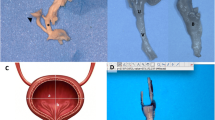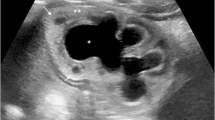Abstract
Background
Our previous study on the Doppler waveform of the urinary jet at the vesicoureteric junction (VUJ) indicates that there is an active sphincteric mechanism in humans. We have also shown that there are immature and mature patterns of the jet, and the VUJ matures around the age of 4 years.
Objective
To determine if there is any gender difference in the time of achieving maturity of the VUJ.
Materials and methods
The Doppler pattern of the jets from both ureters was recorded in 273 normal boys and 248 normal girls. The subjects were considered to have immaturity of the VUJ if an immature jet waveform was detected in either ureter.
Results
The mean age of VUJ maturity was 4.54 years for the whole population, 4.88 years for boys and 4.34 years for girls. The difference between ROC curves for boys and girls was not significant (P > 0.05, simple Z test).
Conclusion
There is no significant gender difference in the maturation of the VUJ. Detection of a persistent immature jet pattern beyond the age of maturity might have prognostic implications if there is a concurrent pathological condition related to the urinary tract in children.




Similar content being viewed by others
References
Leung VY, Metreweli C, Yeung CK (2002) The ureteric jet Doppler waveform as an indicator of vesicoureteric sphincter function in adults and children. An observational study. Ultrasound Med Biol 28:865–872
Leung VY, Metreweli C, Yeung CK (2002) Immature ureteric jet Doppler patterns and urinary tract infection and vesicoureteric reflux in children. Ultrasound Med Biol 28:873–878
Winberg J, Andersen HJ, Bergström T et al (1974) Epidemiology of symptomatic urinary tract infection in childhood. Acta Paediatr Scand Suppl (252):1–20
Smellie JM, Hodson CJ, Edwards D et al (1964) Clinical and radiological features of urinary infection in childhood. Br Med J 2:1222–1226
So LY, Davies DP (1988) Urinary tract infection in childhood: a study of 137 cases. Hong Kong J Paediatr 1:17–24
Hellström A, Hanson E, Hansson S et al (1991) Association between urinary symptoms at 7 years old and previous urinary tract infection. Arch Dis Child 66:232–234
Leung VY, Chu WC, Yeung CK et al (2006) Ureteric jet Doppler waveform and bladder wall thickness in children with nocturnal enuresis. Pediatr Res 60:582–586
Dixon JS, Jen PY, Yeung CK et al (1998) The structure and autonomic innervation of the vesico-ureteric junction in cases of primary ureteric reflux. Br J Urol 81:146–151
Skoog SJ, Belman AB, Massoud M (1987) A nonsurgical approach to the management of primary vesicoureteral reflux. J Urol 138:941–946
Hutch JA (1961) Theory of maturation of the intravesical ureter. J Urol 86:534–538
Yeung CK, Godley ML, Dhillon HK et al (1997) The characteristics of primary vesicoureteric reflux in male and female infants with prenatal hydronephrosis. Br J Urol 80:319–327
Lenaghan D, Whitaker JG, Jensen F et al (1976) The natural history of reflux and long-term effects of reflux on the kidney. J Urol 115:728–730
Gordon AC, Thomas DF, Arthur RJ et al (1990) Prenatally diagnosed reflux: a follow-up study. Br J Urol 65:407–412
Yeung CK, Godley ML, Dhillon HK et al (1998) Urodynamic patterns in infants with normal lower urinary tracts on primary vesicoureteric reflux. Br J Urol 81:461–467
Anderson PA, Rickwood AM (1991) Features of primary vesicoureteric reflux detected by prenatal sonography. Br J Urol 67:267–271
Najmaldin A, Burge DM, Atwell JD (1990) Reflux nephropathy secondary to intrauterine vesicoureteric reflux. J Pediatr Surg 25:387–390
O’Donnell B, O’Connor TP (1971) Bladder function in infants and children. Br J Urol 43:25–27
Yeung CK (1995) The normal infant bladder. Scand J Urol Nephrol Suppl 173:19–23
Yeung CK, Godley ML, Duffy PG et al (1995) Natural filling cystometry in infants and children. Br J Urol 75:531–537
Yeung CK, Godley ML, Ho CK et al (1995) Some new insights into bladder function in infancy. Br J Urol 76:235–240
Koff SA, Wagner TT, Jayanthi VR (1998) The relationship among dysfunctional elimination syndromes, primary vesicoureteral reflux and urinary tract infections in children. J Urol 160:1019–1022
Author information
Authors and Affiliations
Corresponding author
Rights and permissions
About this article
Cite this article
Leung, V.Yf., Chu, W.Cw., Yeung, Ck. et al. Gender difference in achieving rate of maturity of the vesicoureteric junction. Pediatr Radiol 37, 189–193 (2007). https://doi.org/10.1007/s00247-006-0378-9
Received:
Revised:
Accepted:
Published:
Issue Date:
DOI: https://doi.org/10.1007/s00247-006-0378-9




